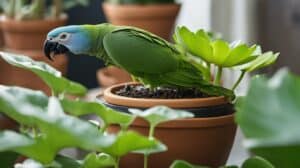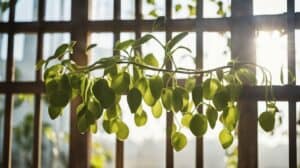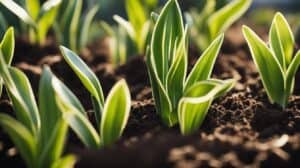Button fern (Pellaea rotundifolia) is a charming, low-maintenance houseplant that can add a touch of green to any space. It is a popular choice among plant enthusiasts due to its unique, round-shaped leaves that resemble buttons. But did you know that you can easily propagate this plant to create new tiny green worlds?

Propagation is the process of creating new plants from existing ones. Button ferns can be propagated through spores or division. Spore propagation involves collecting and sowing spores to grow new plants, while division propagation involves separating the plant into smaller sections and replanting them. Both methods are relatively easy and can be done at home with a few simple steps. In this article, we will explore the basics of button fern propagation to help you expand your plant collection and create more tiny green worlds.
Understanding Button Ferns

Species Overview
Button Ferns, scientifically known as Pellaea rotundifolia, are native to New Zealand and are a popular houseplant due to their small size and attractive foliage. They are part of the Pteridaceae family and are characterized by their circular fronds that resemble buttons.
Button Ferns are relatively easy to care for and can thrive in a variety of environments. They are a great choice for beginners and experienced plant owners alike. They are also known for their air-purifying properties, making them a popular choice for indoor spaces.
Ideal Growing Conditions
Button Ferns prefer bright, indirect light and well-draining soil. They can tolerate lower light conditions, but growth may be slower. It’s important to avoid direct sunlight as this can scorch the delicate fronds.
They also thrive in humid environments, so it’s a good idea to mist the plant regularly or place it on a tray of pebbles filled with water to increase humidity levels. The ideal temperature range for Button Ferns is between 60-75°F (15-24°C).
When it comes to watering, it’s important to keep the soil consistently moist but not waterlogged. Overwatering can lead to root rot and other issues. It’s a good idea to allow the top inch of soil to dry out before watering again.
In summary, Button Ferns are a popular and easy-to-care-for houseplant that can thrive in a variety of environments. With the right growing conditions, they can add a touch of greenery and air-purifying benefits to any indoor space.
Propagation Techniques
Spore Collection and Sowing
Button ferns can be propagated through spores, which are produced on the undersides of the leaves. To collect spores, wait for the leaves to mature and develop brown spots on the underside. Once the spots appear, cut off the frond and place it in a paper bag to dry for a few days. The spores will fall off and collect at the bottom of the bag.
To sow the spores, create a mixture of half peat moss and half perlite. Wet the mixture and then sprinkle the spores on top. Cover the container with plastic wrap to keep the humidity high. Place the container in a bright area, but out of direct sunlight. The spores will germinate in a few weeks.
Division Method
Button ferns can also be propagated through division. To do this, remove the plant from its pot and gently separate the roots. Use a clean knife or scissors to cut the roots and leaves into sections. Make sure each section has a healthy root system and at least one frond.
Plant the sections in a well-draining soil mixture and water thoroughly. Keep the soil moist but not waterlogged. Place the newly divided plants in a bright area, but out of direct sunlight. The new plants will establish themselves in a few weeks and start producing new fronds.
Post-Propagation Care

After propagating button ferns, it is important to provide proper care to ensure their growth and health. This section will cover the basics of post-propagation care, including watering and feeding, light and temperature, and common pests and diseases.
Watering and Feeding
Button ferns require consistent moisture to thrive. Watering should be done when the soil feels dry to the touch but not completely dry. Overwatering can lead to root rot, so it is important to avoid letting the soil become waterlogged. It is recommended to use a well-draining soil mix and a pot with drainage holes to prevent water from accumulating.
Feeding button ferns with a balanced fertilizer every two to four weeks during the growing season can help promote healthy growth and vibrant foliage. It is important to follow the instructions on the fertilizer package and avoid over-fertilizing, which can damage the plant.
Light and Temperature
Button ferns prefer bright, indirect light, but can also tolerate lower light conditions. Direct sunlight can scorch the leaves, so it is important to avoid placing them in direct sunlight. They also prefer temperatures between 60-75°F (15-24°C) and high humidity levels.
Common Pests and Diseases
Button ferns are generally pest and disease resistant, but they can still be susceptible to common issues such as mealybugs, spider mites, and scale insects. Regularly inspecting the plant for signs of pests and promptly treating any infestations can help prevent further damage. Overwatering can also lead to root rot, which can be prevented by ensuring proper drainage and not letting the soil become waterlogged.
Overall, providing proper care for button ferns after propagation can help ensure their growth and health. By following these basic guidelines for watering and feeding, light and temperature, and pest and disease prevention, button ferns can thrive and bring a touch of green to any space.
Frequently Asked Questions

What are the ideal conditions for propagating Button Ferns?
Button Ferns thrive in warm and humid environments. To propagate Button Ferns, it is best to provide them with a temperature range of 65-75°F and a humidity level of 60-70%.
Can you explain the step-by-step process for propagating a Button Fern?
To propagate a Button Fern, start by selecting a healthy parent plant and taking a cutting of the frond. Place the cutting in a pot filled with a well-draining soil mix and keep it moist. After a few weeks, the cutting should develop roots and new growth.
What kind of soil mix is best for Button Fern propagation?
Button Ferns prefer a well-draining soil mix that is rich in organic matter. A mix of peat moss, perlite, and vermiculite in equal parts is ideal for Button Fern propagation.
How often should Button Ferns be watered during the propagation phase?
During the propagation phase, it is important to keep the soil moist but not waterlogged. Water the Button Fern cutting once a week or when the soil feels dry to the touch.
What are the common signs of successful Button Fern propagation?
Successful Button Fern propagation can be identified by the appearance of new growth and roots. The cutting should also remain green and healthy-looking.
How long does it take for a propagated Button Fern to grow new fronds?
It can take several weeks for a propagated Button Fern to grow new fronds. However, with the right conditions and care, the new growth should appear within a few months.













